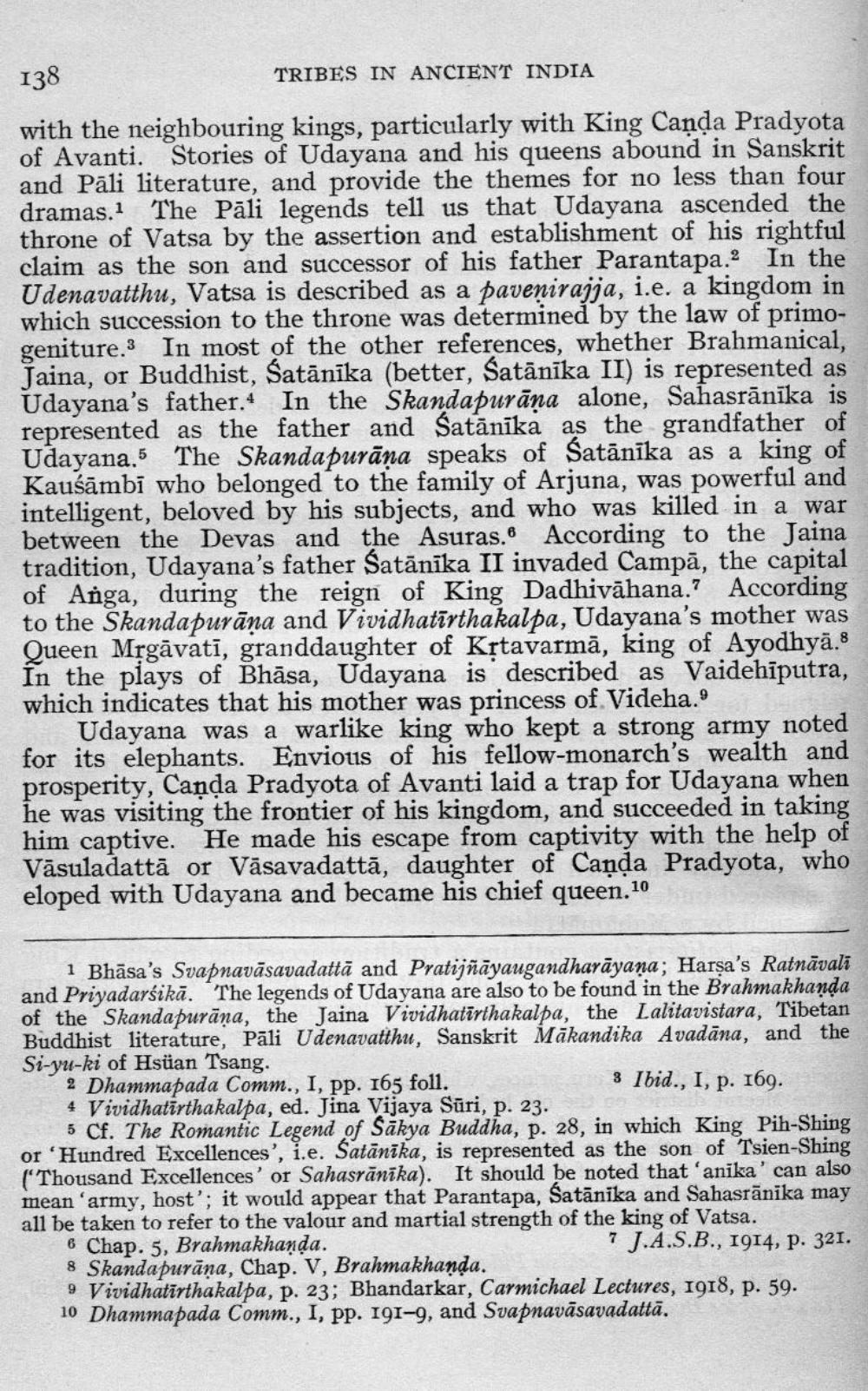________________
138
TRIBES IN ANCIENT INDIA
with the neighbouring kings, particularly with King Caņda Pradyota of Avanti. Stories of Udayana and his queens abound in Sanskrit and Pāli literature, and provide the themes for no less than four dramas.1 The Pāli legends tell us that Udayana ascended the throne of Vatsa by the assertion and establishment of his rightful claim as the son and successor of his father Parantapa. In the Udenavatthu, Vatsa is described as a pavenirajja, i.e. a kingdom in which succession to the throne was determined by the law of primogeniture. In most of the other references, whether Brahmanical, Jaina, or Buddhist, Satānīka (better, Satānika II) is represented as Udayana's father. In the Skandapurāna alone, Sahasrānīka is represented as the father and Satānīka as the grandfather of Udayana.5 The Skandapurāna speaks of Satānīka as a king of Kaušāmbi who belonged to the family of Arjuna, was powerful and intelligent, beloved by his subjects, and who was killed in a war between the Devas and the Asuras. According to the Jaina tradition, Udayana's father Satānīka II invaded Campā, the capital of Anga, during the reign of King Dadhivāhana.? According to the Skandapurāna and Vividhatīrthakalpa, Udayana's mother was Queen Mțgāvatī, granddaughter of Krtavarmā, king of Ayodhyā.8 In the plays of Bhāsa, Udayana is described as Vaidehīputra, which indicates that his mother was princess of Videha.!
Udayana was a warlike king who kept a strong army noted for its elephants. Envious of his fellow-monarch's wealth and prosperity, Canda Pradyota of Avanti laid a trap for Udayana when he was visiting the frontier of his kingdom, and succeeded in taking him captive. He made his escape from captivity with the help of Vāsuladattā or Vāsavadattā, daughter of Caņda Pradyota, who eloped with Udayana and became his chief queen.10
| 1 Bhāsa's Svapnavāsavadattā and Pratijñāyaugandharāyana; Harya's Ratnāvali and Priyadarśikā. The legends of Udayana are also to be found in the Brahmakhanda of the Skanda purāna, the Jaina Vividhatirthakalpa, the Lalitavistara, Tibetan Buddhist literature, Pāli Udenavatthu, Sanskrit Mākandika Avadāna, and the Si-yu-ki of Hsüan Tsang. 2 Dhammapada Comm., I, pp. 165 foll.
3 Ibid., 1, p. 169. 4 Vividhatirthakalpa, ed. Jina Vijaya Sūri, p. 23.
5 Cf. The Romantic Legend of Sākya Buddha, p. 28, in which King Pih-Shing or 'Hundred Excellences', i.e. Satānika, is represented as the son of Tsien-Shing [Thousand Excellences' or Sahasrānika). It should be noted that'anika' can also mean 'army, host'; it would appear that Parantapa, Satānika and Sahasrānika may all be taken to refer to the valour and martial strength of the king of Vatsa. 6 Chap. 5, Brahmakhanda.
7 J.A.S.B., 1914, p. 321. 8 Skandapurāna, Chap. V, Brahmakhanda. 9 Vividhatirthakalpa, p. 23; Bhandarkar, Carmichael Lectures, 1918, p. 59. 10 Dhammapada Comm., 1, pp. 191-9, and Svapnavāsavadattā.




